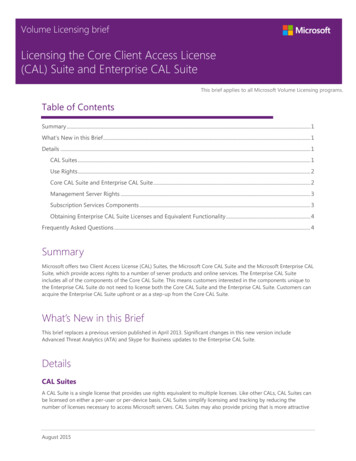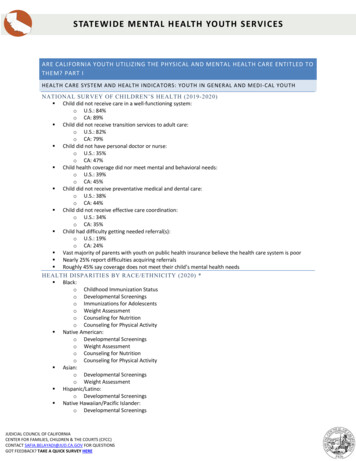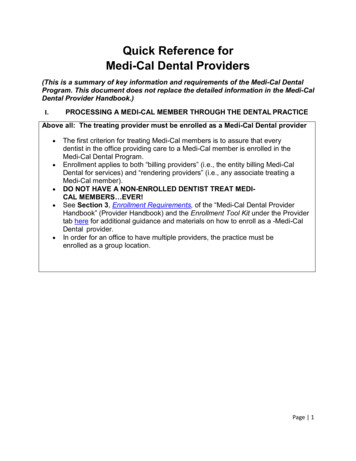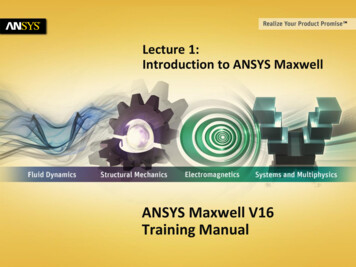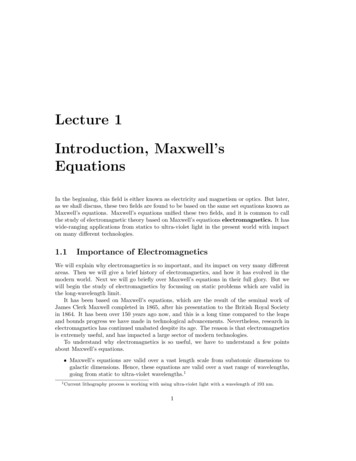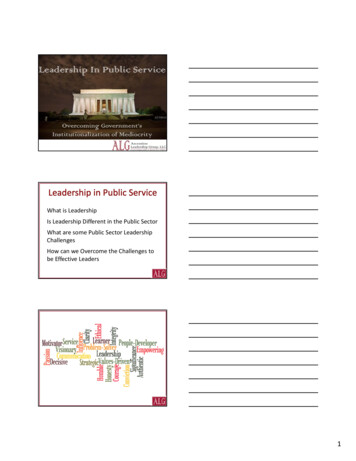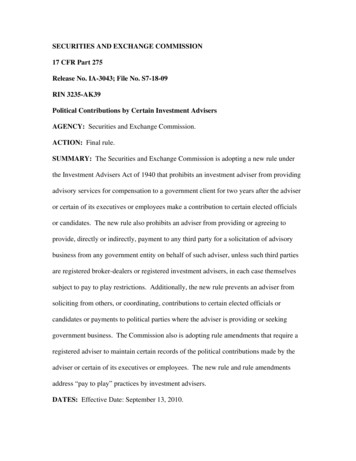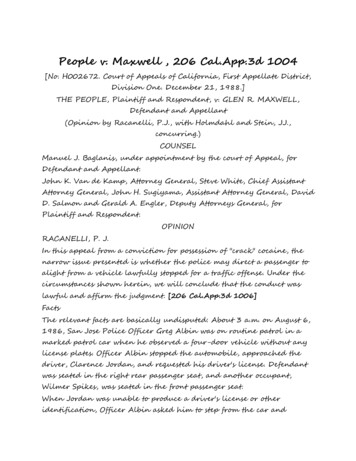
Transcription
People v. Maxwell , 206 Cal.App.3d 1004[No. H002672. Court of Appeals of California, First Appellate District,Division One. December 21, 1988.]THE PEOPLE, Plaintiff and Respondent, v. GLEN R. MAXWELL,Defendant and Appellant(Opinion by Racanelli, P.J., with Holmdahl and Stein, JJ.,concurring.)COUNSELManuel J. Baglanis, under appointment by the court of Appeal, forDefendant and Appellant.John K. Van de Kamp, Attorney General, Steve White, Chief AssistantAttorney General, John H. Sugiyama, Assistant Attorney General, DavidD. Salmon and Gerald A. Engler, Deputy Attorneys General, forPlaintiff and Respondent.OPINIONRACANELLI, P. J.In this appeal from a conviction for possession of "crack" cocaine, thenarrow issue presented is whether the police may direct a passenger toalight from a vehicle lawfully stopped for a traffic offense. Under thecircumstances shown herein, we will conclude that the conduct waslawful and affirm the judgment. [206 Cal.App.3d 1006]FactsThe relevant facts are basically undisputed: About 3 a.m. on August 6,1986, San Jose Police Officer Greg Albin was on routine patrol in amarked patrol car when he observed a four-door vehicle without anylicense plates. Officer Albin stopped the automobile, approached thedriver, Clarence Jordan, and requested his driver's license. Defendantwas seated in the right rear passenger seat, and another occupant,Wilmer Spikes, was seated in the front passenger seat.When Jordan was unable to produce a driver's license or otheridentification, Officer Albin asked him to step from the car and
eventually turned him over to a "back-up" officer (Jones) on thesidewalk.Officer Albin then returned to the vehicle intending to question thepassengers separately concerning the driver's identity and to determineif either had a driver's license so that the vehicle could be drivenaway from the scene.Officer Albin first approached defendant because he did not want toturn his back towards the other passenger. He then, as was his practice,asked defendant to "step out of the car" or "exit the car" for reasons ofhis own safety fn. 1 and in order to separate the two passengers duringquestioning on the driver's identity.As defendant alighted from the car, he threw to the ground two plasticbaggies believed to contain crack cocaine. Defendant was immediatelyarrested and taken to the police station where he was strip searchedduring booking. The search disclosed several additional baggies, one ofwhich contained crack cocaine and three others a white residue.Discussion[1a] The sole question on appeal is whether Officer Albin was justifiedin asking defendant to get out of the car. The officer conceded that hehad no suspicion that defendant, a rear seat passenger, had engaged inany criminal activity and, as noted, had no reason to believedefendant was armed or dangerous. Defendant argues, accordingly, thatthe request was improper and constituted an unlawful detention.[2] Our standard of review of a Fourth Amendment claim involves atwo step process: The trial court's factual findings, when supported by[206 Cal.App.3d 1007] substantial evidence, are binding on appeal;but, as a reviewing court, we must independently determine whether,on the facts found, the search (or detention) was reasonable within themeaning of the Constitution. (People v. Leyba (1981) 29 Cal.3d 591,596-597 [174 Cal.Rptr. 867, 629 P.2d 961].) And where, as here, theevidence is uncontradicted, no factual issue exists requiring reviewunder the substantial evidence standard, and we measure the factsagainst constitutional standards as pure questions of law. (People v.
Aldridge (1984) 35 Cal.3d 473, 477 [198 Cal.Rptr. 538, 674 P.2d240].) In so doing, we apply principles of federal constitutional law todetermine the validity of the challenged detention. (In re Lance W.(1985) 37 Cal.3d 873, 886-888 [210 Cal.Rptr. 631, 694 P.2d 744].)In the seminal case of Pennsylvania v. Mimms (1977) 434 U.S. 106 [54L.Ed.2d 331, 98 S.Ct. 330], the United States Supreme Court held thepolice could order the driver of a lawfully detained vehicle out of thecar without an articulable suspicion that criminal activity was afootor that the occupants of the vehicle posed a threat to police safety. (434U.S. at p. 108 [54 L.Ed.2d at p. 3 35].) The court reached itsdetermination after balancing the de minimis intrusion upon thedriver's liberty against the legitimate concerns for officer safety. (434U.S. at pp. 108-111 [54 L.Ed.2d at pp. 335-337].)[1b] The question left unresolved by Mimms is whether the same ruleapplies equally to passengers.Defendant underscores the emphasis in Mimms to the fact that thedriver was already lawfully detained in reaching the question there aswhether the "incremental intrusion" resulting from the request to getout of the car was reasonable. (434 U.S. at p. 109 [54 L.Ed.2d at p.336], italics added; see also p. 111, fn. 6 [54 L.Ed.2d at p. 337].) Thus,defendant argues, unlike the driver of a lawfully stopped vehicle, apassenger is not under detention, and the police must haveindependent cause to detain in order to justify a demand that thepassenger alight.The People counter there is no significant difference between the statusof a driver or passenger with respect to the officer's safety. In fact, it isargued, a passenger may pose an even greater danger because the officercannot safely observe the passenger while interviewing the driver.Accordingly, the People urge this court to extend the rule announcedin Mimms to authorize the police to routinely require any occupants ofa lawfully stopped vehicle, including passengers, to alight from thevehicle.First, we reject defendant's argument that the level of suspicion or cause
to order a passenger to alight is the same as that necessary for atemporary [206 Cal.App.3d 1008] detention. Nor do we believe, assuggested by the People, that it is necessary or desirable to fashion a"bright-line" rule uniformly applicable to all vehicle stops. As willappear, we think each case must be examined on its own peculiar factsfor a determination whether the police conduct was constitutionallyjustified.California courts have long recognized that a police officer may ask adriver or a passenger to get out of a vehicle in an appropriate case. InPeople v. Superior Court (Simon) (1972) 7 Cal.3d 186 [101 Cal.Rptr.837, 496 P.2d 1205], the court held the police may not routinelysearch a motorist stopped for a traffic violation to look for weaponswithout specific articulable facts furnishing grounds for the officer tobelieve the motorist may be armed. But the court openly cautioned thatit did not mean "to cast doubt on the use by the police, whenappropriate, of other precautionary measures which constitute a lesserintrusion than a pat-down search, such as directing the suspect toalight from his car or to keep his hands in sight." (7 Cal.3d at p. 206,fn. 13; see also People v. Mickelson (1963) 59 Cal.2d 448, 450 [30Cal.Rptr. 18, 380 P.2d 658] [if circumstances warrant, police officermay request a suspect to alight from automobile for safety reasons].)Shortly thereafter, in People v. Beal (1974) 44 Cal.App.3d 216 [118Cal.Rptr. 272], the appellate court identified two sets of "appropriatecircumstances" for ordering a passenger out of the car: 1) to enable theofficer to pursue his investigation, or 2) to insure the officer's safety. InBeal, having first observed two men stagger to their vehicle, the policestopped the car after it had proceeded a block and a half to determinewhether the occupants were intoxicated. The reviewing court expresslyheld that the officer was justified in ordering the passenger (appellant)out of the lawfully stopped car in order to verify his sobriety and toinsure the officer's own safety. "Since the purpose of the stop was 'toascertain if these people were intoxicated,' it was permissible to ask theoccupants to alight in order to view their condition. [Citations.] [¶]
Furthermore, it has been held proper to request the occupants to alightin order to insure the safety of the officer. [Citations.] Officer Nustadtestified that whmn he asked appellant to get out of the vehicle hefeared for his own safety because 'I was wondering what was stuckunderneath the seat .' [] [E]ven an inchoate and unparticularizedsuspicion that it would be better for the officer's safety for the passengerto alight is sufficient to justify such a request, because merely steppingout of the vehicle is a minimal intrusion upon privacy, far less thaninvolved in a bodily search, a frisk, or a search of the vehicle. (Peoplev. Superior Court (Simon), supra; People v. Superior Court (Kiefer)[1970] [3 Cal.3d 807] at p. 830.) The officer's request that appellantalight from the vehicle was perfectly reasonable and proper." (44Cal.App.3d at pp. 220-221; see also People v. Remiro (1979) 89Cal.App.3d 809, 829 [153 [206 Cal.App.3d 1009] Cal.Rptr. 89,2A.L.R.4th 1135] [driver and passenger suspected of burglary].)More recently, this court (Div. Three) reiterated that a legitimateconcern for officer safety provides sufficient justification for asking apassenger to get out of a car stopped for traffic violations. (People v.Padilla (1982) 132 Cal.App.3d 555, 557-558 [183 Cal.Rptr. 97][passenger kept his hands in his pockets and fidgeted nervously].)Courts of other jurisdictions have generally followed a similaranalytical approach, adopting a test of reasonableness justifying theofficer's instruction that the passenger alight. (People v. McLaurin(1987) 70 N.Y.2d 779 [515 N.E.2d 904] [late hour; abandoned area;slow-moving, unlighted car]; United States v. Hardnett (6th Cir. 1986)804 F.2d 353 [reasonable suspicion that occupants of car were armed];State v. Willis (Minn. 1982) 320 N.W.2d 726, 728 [furtive gestures bypassenger and observation of rubber face mask on floor]; People v.Bradi (1982) 107 Ill.App.3d 594 [437 N.E.2d 1285] [driver gave falseidentification; officer saw partially concealed champagne bottle]; Statev. Williams (Fla.App. 1979) 371 So.2d 1074, cert. den. (Fla. 1980) 381So.2d 771 [citizen hearsay report of a gun in the car]; State v. Collins(1978) 38 N.C.App. 617 [248 S.E.2d 405] [officers observed open
liquor bottles at passenger's feet].)Neither party has cited, nor has our independent research disclosed,any decision in which the court has extended the Mimms rationaleupholding the officer's authority to order a passenger to exit a lawfullystopped vehicle without any articulable justification. To the contrary,some language appears suggesting the necessity of a threshold level ofsuspicion focused on the passenger. (People v. Marin (1981) 80App.Div.2d 541 [436 N.Y.S.2d 292] ["the passengers may not be orderedout absent some suspicion directed at them," but no improper conductbecause the passenger got out without an order]; State v. Williams (La.1978) 366 So.2d 1369 [Mimms not applicable to passengers;individualized reasons required; dictum: routine intrusion violatesLouisiana constitutional right of privacy].)The case bearing the closest factual resemblance is State v. Ferrise(Minn. 1978) 269 N.W.2d 888. There, the court found the officer'sconduct in ordering the passenger out of the car to be reasonable wherethe driver had no identification and the officer "wanted to see if thepassenger could aid [the police] in accurately identifying the driver soa license check could be made." fn. 2 (Id., at p. 891.) [206 Cal.App.3d1010]In the case before us, Officer Albin articulated a similar reason forwanting defendant out of the car: namely, to pursue his inquiry in anattempt to learn the identity of a driver of a car without license plates,who was unable to produce any identification or vehicle registration.Such a routine official investigation, conducted in a manner so as toassure independent reliability, was eminently reasonable under thecircumstances shown.Moreover, the challenged order or request to alight was justified onanother wholly independent basis: a legitimate concern for the officer'spersonal safety. To recapitulate, upon effecting the early morning stopof a vehicle containing three occupaots, the officer was faced with theprospect of interviewing the two passengers in an effort to establish theidentity of the driver. His decision to separate them for his own
protection, while closely observing defendant as he rummaged throughhis pockets for identification, was amply justified and reasonableunder the circumstances presented. No improper constitutionalencroachment occurred as claimed.We conclude that the minimal intrusion on defendant's liberty wasfully justified both by the officer's concern for his safety and thepalpable necessities of effectively carrying out his official duties. [3] Inview of our determination, we need not discuss the remainingarguments raised in the briefs. fn. 3The judgment is affirmed.Holmdahl, J., and Stein, J., concurred.FN 1. Officer Albin had no reason to believe that defendant wasarmed or dangerous.FN 2. The Ferrise court also suggested by way of dictum that theMimms analysis would apply equally to passengers. (269 N.W.2d at pp.890-891.) However, in a subsequently decided case, the same courtqualified its endorsement of the earlier dictum and chose, instead, touphold the police conduct under a standard of reasonableness: "Giventhe time, place and the circumstances, Officer Steffen clearly wasjustified in ordering the passengers out in order to get them away fromwhat might well be a weapon under the seat." (State v. Willis, supra,320 N.W.2d at p. 728.)FN 3. However, we note in passsing that People v. Spicer (1984) 157Cal.App.3d 213 [203 Cal.Rptr. 599], relied upon by defendant, isfactually distinguishable. In Spicer, the court upheld the magistrate'svacated order of suppression on the basis of an illegal detention of thepassenger-defendant who had been peremptorily -- and withoutexplanation -- ordered to produce her driver's license. The courtreasoned that because defendant had no realistic choice to ignore thedemand or to leave the scene, the "close encounter" constituted anunlawful detention. Here, in contrast, the mere request to exit thevehicle, under the specific circumstances shown, did not amount to adetention within the meaning of the Fourth Amendment. (People v.
Harris (1986) 184 Cal.App.3d 1319, 1322 [229 Cal.Rptr. 400].)
Maxwell , 206 Cal.App.3d 1004 [No. H002672. Court of Appeals of California, First Appellate District, . John K. Van de Kamp, Attorney General, Steve White, Chief Assistant . 7 Cal.3d 186 [101 Cal.Rptr. 837, 496 P.2d 1205], the court held the police may not routinely search a motorist stopped for a traffic violation to look for weapons .

